|
 Phellodon sinclairii Phellodon sinclairii
SynonymsHydnum sinclairii
BiostatusPresent in region - Indigenous. Endemic
Images (click to enlarge)
Caption: 1b. spores of Phellodon sinclairii, x 1,000. Original. | 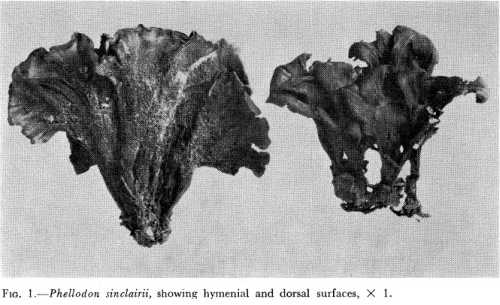
Caption: Fig. 1. Phellodon sinclairii, showing hymenial and dorsal surfaces, x1. | 
Owner: G.M.Taylor | 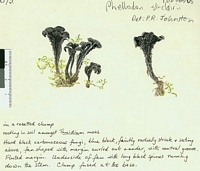
Caption: Watercolour
Owner: G.M. Taylor | 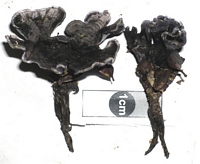
Owner: J.A. Cooper | 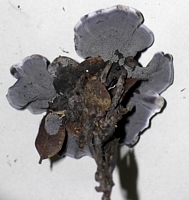
Owner: J.A. Cooper | 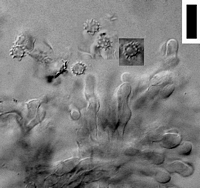
Caption: scale = 10um. Spores
Owner: J.A. Cooper | 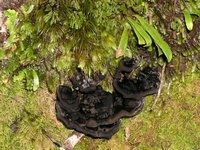
Owner: J.A. Cooper | 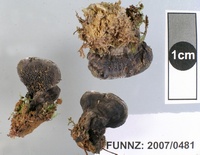
Owner: J.A. Cooper | 
Caption: FUNNZ2007/0481
Owner: FUNNZ | 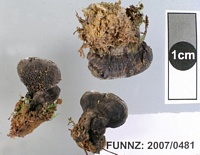
Caption: FUNNZ2007/0481
Owner: FUNNZ |
Article: Cunningham, G.H. (1958). Hydnaceae of New Zealand. Part I. The pileate genera Beenakia, Dentinum, Hericium, Hydnum, Phellodon and Steccherinum. Transactions of the Royal Society of New Zealand 85(4): 585-601.
Description: Hymenophore annual, coriaceous, pileate. Pilei stipitate, flabelliform with excentric stems, or
campanulate with central stems, usually aggregated into groups of 3-5 with free stems but
fused margins, sometimes forming rosettes, less frequently solitary, 2-5 cm tall, 1-5 cm
radius. Pileus surface black, glabrous, radiately sulcate; margin incurved, thin, lobed or
complicate. Hymenial surface black, tinted olivaceous, with a broad sterile border. Stems 0.5-2 cm x 1-5 mm, concolorous, flattened or terete, solid, glabrous save towards the base where
sometimes tomentose, arising from a common mycelial mass. Spines decurrent, 0.5-2 mm
long, subulate, terete, crowded, black with an olivaceous tinge. Context 0.5-1.5 mm thick,
black, shining, composed of parallel hyphae firmly compacted; generative hyphae 3.5-4.5 µ
diameter, walls 0.2 µ thick, coloured with black pigment granules, sparsely branched, septate,
without clamp connexions. Hymenial layer to 30µ deep, a dense palisade of basidia and
paraphyses. Basidia subclavate, 18-22 x 5-6 µ, 2-4-spored; sterigmata erect, slender, to 4 µ
long. Paraphyses subclavate, 16-20 x 5-6 µ. Spores globose, 4-5 µ diameter (with spines 5-6
µ), walls moderately verruculose (spines 0.5 µ long), hyaline, 0.1 µ thick.
Habitat: HABITAT: In humus on the floor of Nothofagus forests.
Distribution: DISTRIBUTION: New Zealand.
Notes: Plants commonly grow in crowded groups with stems free but margins fused to form rosettes,
when pilei are flabelliform with excentric or lateral stems. Solitary pilei are usually
campanulate with central stems. The entire plant is black when dry, colour being produced
from black pigment granules embedded in walls of hyphae. Purple when they first emerge
from the humus under beech trees, plants rapidly change to fuscous, then black. When fertile
the hymenial surface assumes an olivaceous tinge, when sterile it also is black. Spores are
globose with hyaline and finely verruculose walls, spines being about 0.5 µ long. Even after
long keeping in the herbarium, plants possess a strong odour of aniseed. Collections match
the type in Kew herbarium, which consists of five specimens in excellent condition, collected
by Dr. Sinclair at Maungatua in 1860.
Article: Cooke, M.C. (1879). New Zealand fungi. Grevillea 8(46): 54-68.
|